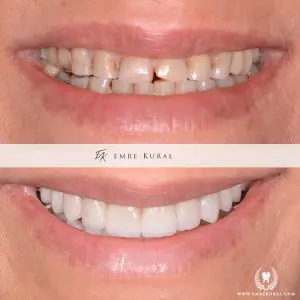
Laminate veneer is a thin layer of restoration applied by minimally abrading the front surface of aesthetically compromised anterior teeth (such as diastema, misaligned, or decayed teeth). Due to its ultra-thin structure, lack of metal, and high light transmittance, it provides excellent results that are indistinguishable from natural teeth. These veneers are precisely prepared and fitted onto the tooth with exceptional accuracy. In most cases, their durability and color stability allow them to provide both natural aesthetics and functionality to the teeth.
The procedure is simple and quick. Laminates are bonded to the teeth using a special technique and an adhesive resin material. Once bonded, they cannot be removed from the teeth, making them highly resistant to fractures.
What Are Full Ceramic Restorations?
Full ceramic restorations are a type of dental crown made entirely of reinforced porcelain, without a metal substructure. They are preferred primarily for their high light transmittance, which makes them more aesthetically pleasing. Since these restorations do not contain metal, they appear more natural and are often used in anterior aesthetic restorations.
They are particularly recommended in cases where laminate veneers are not suitable, such as extensively damaged teeth due to decay, fractures, or other structural issues.
The process involves removing 1.7-2 mm of tooth structure from all around the tooth in a painless manner. After taking the main impression, temporary crowns are placed. The final full ceramic restorations are then fabricated in the laboratory based on the impression. Once the laboratory work is completed, a trial fitting is done before permanently bonding the restoration to the tooth.
Because full ceramic restorations bond to the tooth both mechanically and chemically, they offer better retention compared to metal-supported restorations.
What Are Zirconium-Supported Ceramic Restorations? When Are They Used?
In aesthetic dentistry, full ceramic restorations were introduced to overcome the limited aesthetic appeal of metal-supported ceramic restorations in the anterior region. However, despite their high aesthetic quality, full ceramic restorations lack sufficient strength for long-span bridges in the posterior region.
To address this issue, zirconium material was introduced as a substructure. Zirconium is a white, semi-translucent material that offers both high aesthetic quality and exceptional strength. These characteristics make zirconium an optimal choice for aesthetic bridges and posterior restorations.
The fabrication process of zirconium-supported ceramic restorations is identical to that of full ceramic restorations.
